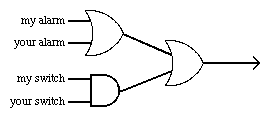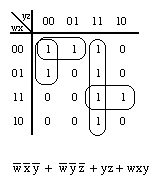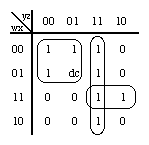
1.

2a.

2b.

2c.
w=0,x=1,y=0,z=1, so that the two doubles could become a quadruple.
2d.

3a.
False. Let a=b=0.
Then the left side is 0 xor 0 = 0
and the right side is (0+0) xor (1+1) = 0 xor 1 = 1
3b.
True.
(a xor b) xor c
= (a notb + nota b) xor c
= ((a notb + nota b) notc) + (not(a notb + nota b) c)
= (a notb notc + nota b notc) + (not(a notb + nota b) c)
= (a notb notc + nota b notc) + (((a+notb)(nota+b)) c)
= (a notb notc + nota b notc) + ((a nota + a b + notb nota + notb b) c)
= (a notb notc + nota b notc) + (a nota c + a b c + notb nota c + notb b c)
base law and identities for (a nota c) and (notb b c):
= a notb notc + nota b notc + a b c + notb nota c
reorder (associative and commutative):
= a b c + a notb notc + nota b notc + nota notb c
3c.
False. Let a=1, b=c=0.
Then the left side is 1 + (0 xor 0) = 1+0 = 1
and the right side is (1+0) xor (1+0) = 1 xor 1 = 0